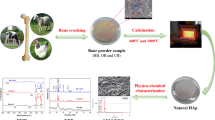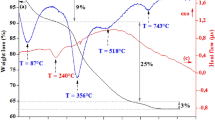Abstract
Further studies on the processing and use of animal-bone-derived calcium phosphate materials in biomedical applications are presented. Bone powders sourced either from the direct crushing and milling of bovine, ovine and cervine bone or after being subjected to defatting and acid digestion/NaOH reprecipitation and sodium hypochlorite hydrogen peroxide treatment of animal bones were characterized using Fourier transform infra-red (FTIR) spectroscopy, 13C solid state magic angle spinning (MAS) nuclear magnetic resonance (NMR) spectroscopy, atomic absorption (AA) and inductively coupled plasma (ICP) spectrometric techniques. Bone powders were trialled for their potential use as a substrate for phosphine coupling and enzyme immobilization as well as a feedstock powder for plasma spraying on titanium metal substrates. Results indicated that enzyme immobilization by phosphine coupling could be successfully achieved on milled cervine bone with the immobilized enzyme retaining some activity. It was found that the presence of impurities normally carried down with the processing of the bone materials (viz., fat and collagen) played an important role in influencing the adsorbency and reactivity of the powders. Plasma spraying studies using reprecipitated bovine-derived powders produced highly adherent coatings on titanium metal, the composition of which was mostly hydroxyapatite(Ca10(PO4)6(OH)2) with low levels of α-tricalcium phosphate (α-Ca3(PO4)2) and tetracalcium phosphate (Ca4P2O9) also detected. In general, animal derived calcium phosphate materials constitute a potentially cheaper source of calcium phosphate materials for biomedical applications and make use of a largely under-utilized resource from abattoir wastes. © 2000 Kluwer Academic Publishers
Similar content being viewed by others
References
L. SAVARINO, S. STEA, D. GRANCHI, M. E. DONATI, M. CERVELLATI, A. MORONI, G. PAGANETTO and A. PIZZOFERRATO, J. Mater. Sci: Mater. Med. 9 (1998) 109.
P. FRAYSSINET, E. ASIMUS, A. AUTEFAGE and J. FAGES, ibid. 6 (1995) 473.
B. F. YETER-DAL, V. GROSS, and T. W. TURNEY in “Ceramics, adding the value, Volume 2” Proceedings of the International Ceramic Conference, Australia, 1992, (CSIRO Publications, Melbourne, 1992) p. 617.
Composition of Ceramic Hydroxylapatite for Surgical Implants, ASTEMF 1185-88.
G. S. JOHNSON, M. R. MUCALO and M. A. LORIER, J. Mater. Sci: Mater. Med., in press.
AOAC International 16th edn (Association of Official Analytical Chemists), 2 (1995) Ch. 39, p. 7.
F. C. COCHRANE, H. H. PETACH and W. HENDERSON, Enzyme and Microbial Technology, 18 (1996) 373.
United States Pharmacopoeia (USP) Twenty First Revision (1985), United States Pharmacopoeial Convention Inc., Maryland, p. 1104.
S. KANO, A. YAMAZAKI, R. OTSUKA, M. OHGAKI, S. NAKAMURA, M. AKAO and H. AOKI, Apatite Volume 1, Proceedings of the First International Symposium on Apatite, Mishima, Japan, July 1991 (Japanese Association of Apatite Science, March, 1992) 91.
Powder Diffraction Files, Pattern numbers: 4-0777 (CaO), 5-0628 (NaCl), 25-1137 (Ca4P2O9) and 9-348 (a-Ca3(PO4)2) Joint Committee on Powder Diffraction Standards, Philadelphia, 1974.
W. KEMP in “NMR in Chemistry, A Multinuclear Introduction”, (Macmillan Education Ltd, London, 1986) p. 217.
E. D. WEIL in “Handbook of Organophosphorus Chemistry” edited by R. Engel (Dekker, New York, 1992) Ch. 14.
W. HENDERSON, G. M. OLSEN and L. S. BONNINGTON, J. Chem. Soc. Chem. Commun. (1994) 1863.
H. H. PETACH, W. HENDERSON and G. M. OLSEN, ibid. (1994) 2181.
W. HENDERSON, H. H. PETACH and L. S. BONNINGTON, Eur. Poly J. 31 (1994) 981.
W. HENDERSON, Chemistry Department, University of Waikato, Private Communication.
J. EVERSE, C. L. GINZBURGH and N. O. KAPLAN in “Methods of Biochemical Analysis” edited by C. Suelter, (Wiley, New York, 1981) p. 135.
R. MCPHERSON, N. GANE and T. J. BASTOW, J. Mater. Sci: Mater. Med. 6 (1995) 327.
L. HENCH and J. WILSON in “An Introduction to Bioceramics, Advanced Series in Ceramics-Vol. 1”, (World Scientific, Singapore, 1993) p. 154, 199.
Author information
Authors and Affiliations
Rights and permissions
About this article
Cite this article
Johnson, G.S., Mucalo, M.R., Lorier, M.A. et al. The processing and characterization of animal-derived bone to yield materials with biomedical applications. Part II: milled bone powders, reprecipitated hydroxyapatite and the potential uses of these materials. Journal of Materials Science: Materials in Medicine 11, 725–741 (2000). https://doi.org/10.1023/A:1008979929632
Issue Date:
DOI: https://doi.org/10.1023/A:1008979929632




